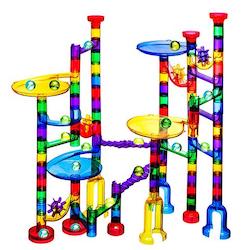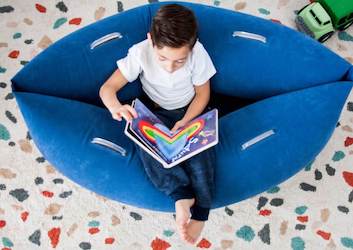Your Cart is Empty

Fact Checked & Updated by Shea Brogren, MOT, OTR/L
There’s a lot to consider when selecting the best autism toys for your toddler, preschool, or school-aged child, classroom, or therapy clients.These toys are suitable for children with autism spectrum disorder, sensory processing disorder, or other special needs.
Children with autism can have limited language, social, and/or sensorimotor skills needed to purposely engage with toys in ways than neurotypical children do.
Many children on the autism spectrum are drawn to items in the environment that have a sensory component. This is no different when it comes to toys. A sensory toy or item is one that stimulates a specific sense in one or more ways. For example, flashing lights, a repetitive song, a certain texture to feel on the toy, may draw a child to that toy.
This can be helpful for a child with an autism spectrum disorder, as their sensory systems often crave certain input or sensory stimulation in order to feel organized or calm. Additionally, for some children with special needs, preferred characters, colors, or themes will make the toy a must-have favorite!
You may be wondering, what is the best toy or gift for a child with autism spectrum disorder? The answer is simple, yet complex. Each and every child is different, so consider your child’s strengths, interests, and abilities when determining which of these recommendations is best suited for him.
For ease of understanding the “why” behind some of these autism toys, we’ve grouped them into categories based on sensory input and skill development (social, cognitive, language, motor). This will also allow you to make your decisions based upon the specific skills your individual child may need additional practice with.
These toys allow for gross motor activities that target whole-body movement and provide vestibular sensory input. Many of these activities combine proprioceptive and vestibular input that can have an organizing effect on the child. When choosing your vestibular toy, consider your child’s sensory profile and how they respond to different types of movement.
Remember that the effects of rotary vestibular input (spinning) can be observed for up to 6-8 hours following just 15 minutes of spinning, so be sure to limit this activity and incorporate some deep pressure following spinning! For more information on vestibular processing, check out our article here.

A tactile toy is sometimes referred to as a fidget. Fidgets are objects that aid with focus and attention by allowing the brain to filter extraneous sensory information. By keeping the hands engaged in simple, repetitive motor movements, the user is able to “tune out” what would otherwise be distracting -- lights, sounds, smells, movement, close proximity to other people. Sometimes, these distractions become too overwhelming.
For children with autism, these tactile fidget tools often become “stim toys” that help them with self-regulation. Keep it simple and low cost for these small sensory toys. For more information, check out our article on Stim Toys and Fidgets.
Some of our top tactile tools are fidgets, others use the sense of touch to support gross and fine motor skills.

Some children with autism like to watch things spin, move, light up, and flash. These toys appeal to strong visual interests and make them instantly appealing! Here are some of our favorites:

Proprioceptive activities provide input to the body’s muscles and joints. This sense has a calming, reorganizing effect that helps children to regulate their arousal levels. Children with autism can have difficulty with self-regulation and overstimulation, so proprioceptive toys provide for deep touch pressure and input that is much-needed!

Occupational Therapists know that integration of the mouth and the suck, swallow, breathe sequence is critical to promote regulation with children who have sensory processing dysfunction (which the majority of children with autism do). Chewing, sucking, and blowing are all motor movements that, especially when used safely in conjunction with other sensory activities, can play a key role in helping your child maintain focus, participation, and regulation.
During times of transition or periods of uncertainty and anxiety, some children revert to sucking and chewing on clothing, hair, or fingers to self-soothe. Here are our favorite “toys” for oral sensory input:

Repetitive, rhythmic auditory feedback can attract some kids to a specific toy. It may drive you a little nuts having to listen to the same musical sounds playing, but your child will be engaged, their listening skills may improve, and that’s what is most important! We’ve included a link to a book about Kids, Music, & Autism for parents to read more about including auditory input and music for teaching and playing! Also, because not every child with autism tolerates auditory sensory input, we’ve included sensory-friendly headphones and noise reduction headphones in our top 10!

Fine motor skills can range from basic to more complex, given the age and development of the child. Some of the toys work on cognitive development and can be fun ways to work on imitation, design copying, building, and turn-taking.
When looking at toys in terms of fine motor skills, consider how your child will manipulate the toys/pieces - using a whole hand, two hands together, or using a more refined grasp like that needed for writing. Add a bit of fun with wiggles or colors to challenge little fingers to move in new ways. It’s important to choose toys that are roughly at your child’s developmental or motor skill level so you provide a “just right challenge” that keeps him engaged while learning/playing.
Toys that challenge gross motor skills work on balance, coordination, hand-eye coordination, muscle strength, endurance, motor planning, and problem-solving! When kids move their bodies in new ways, their brains are learning through movement and sensory feedback. All of our favorite gross motor staples can grow with your child and be used to expand on language, social, cognitive, AND motor skills!
Pretend play toys offer opportunities for social language development and exposure to daily life situations - from modeling going to the doctor, to reenacting a grocery shopping trip! Add the basics for pretend play toys, add a bit of creativity (and a little adult support possibly), and watch imagination take flight and skills develop. Act out the social stories to prepare your child for difficult transitions or community outings, or reinforce language skills when they recreate scripts from favorite TV shows! We’ve even linked you to a DVD that teaches kids pretend play skills through video modeling.
A sensory room is a room or area and often a “safe place” for a child with an autism spectrum disorder or sensory processing disorder to retreat when needed. A sensory room typically will include items that the child finds calming, organizing, and may include sensory items that are needed for the child’s specific daily sensory diet.
A sensory diet is a prescribed routine of activities for your child that will provide the amount of sensory stimulation they need to manage their day. This can include activities that “wake up” or alert the child’s sensory system or activities that calm the child’s sensory system and help them cope.
An occupational therapist can create an individualized plan, with suggested sensory toys or equipment. Below are some sensory toys that are often included in a sensory room. Many of these items have been listed in the above categories, but are listed again, as they are items most commonly found in sensory rooms.

Want more information on sensory rooms? Read our blog post on them here.
There’s always something new in tech that can support your child’s development. Again, keep in mind that you want to find the tech-based toy that fits your child’s skillset and doesn’t provide too much of a challenge that it is frustrating or off-putting! Technology can support language, problem-solving, engagement, and motor skills in motivating ways. Newest innovations are including robotics to teach social skills, routines, facial expressions, and language skill
In case you’ve been counting along...that brings the list to 100. What’s the 101st toy on our list?
No toy can replace the invaluable skills your child will learn from YOU. So, take our 100 ideas for fun and engage with your child. Play in new ways, interact by doing what excites and motivates him. Crawl through the tunnels, play the part, take turns on the trampoline (ok, maybe not the mini tramps!).
Encourage skill development by modeling and commenting on what you’re playing. You have the ability to become what attracts your child’s attention just as much as the toys - sing, move, tickle, squish, calm, teach, and laugh. Have fun!
I’m giving your article a 5-star rating for interesting and informative content. I enjoy reading articles that are so very well-written.
Enlightening article and nice choices.
www.talkinginpictures.co.uk
Comments will be approved before showing up.



Nicole
January 22, 2021
Hi Oli & Erica,
Thank you so much for reading our blog. We’re glad that it’s been so helpful!
Have a great day,
Nicole
Harkla Happiness Ninja